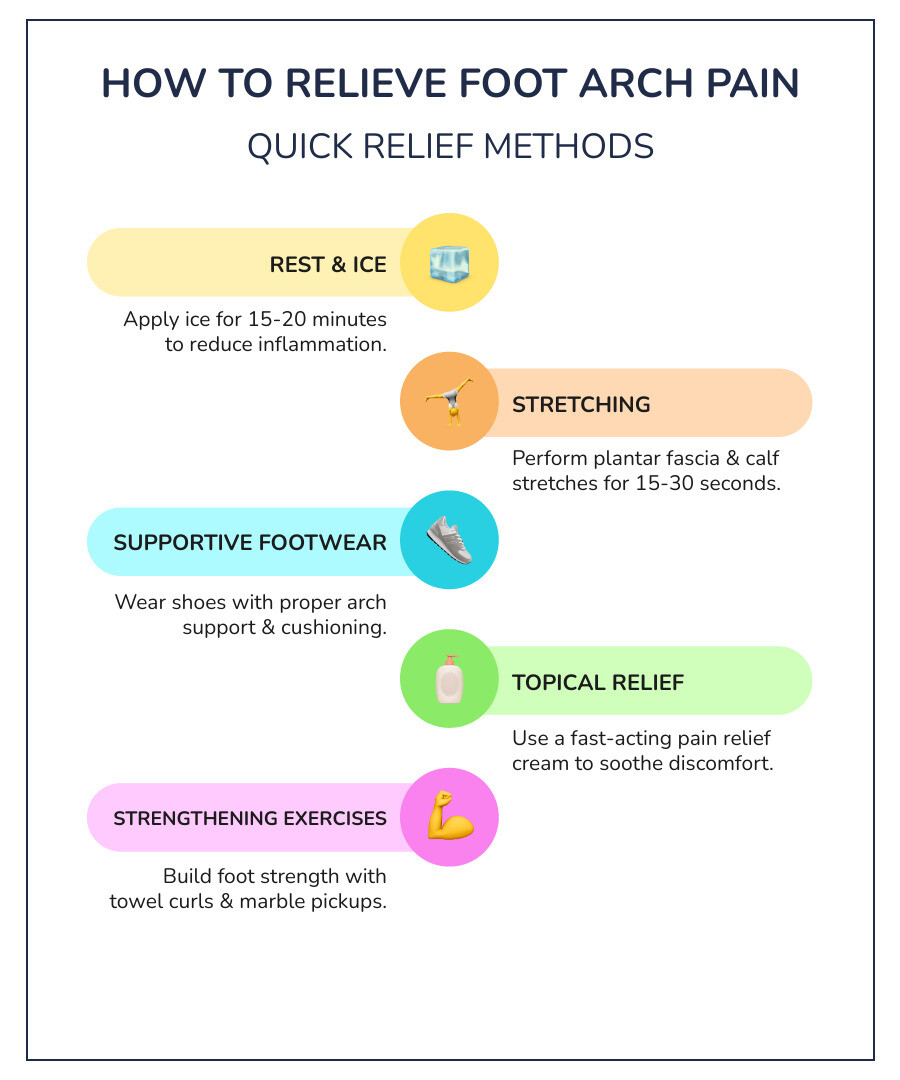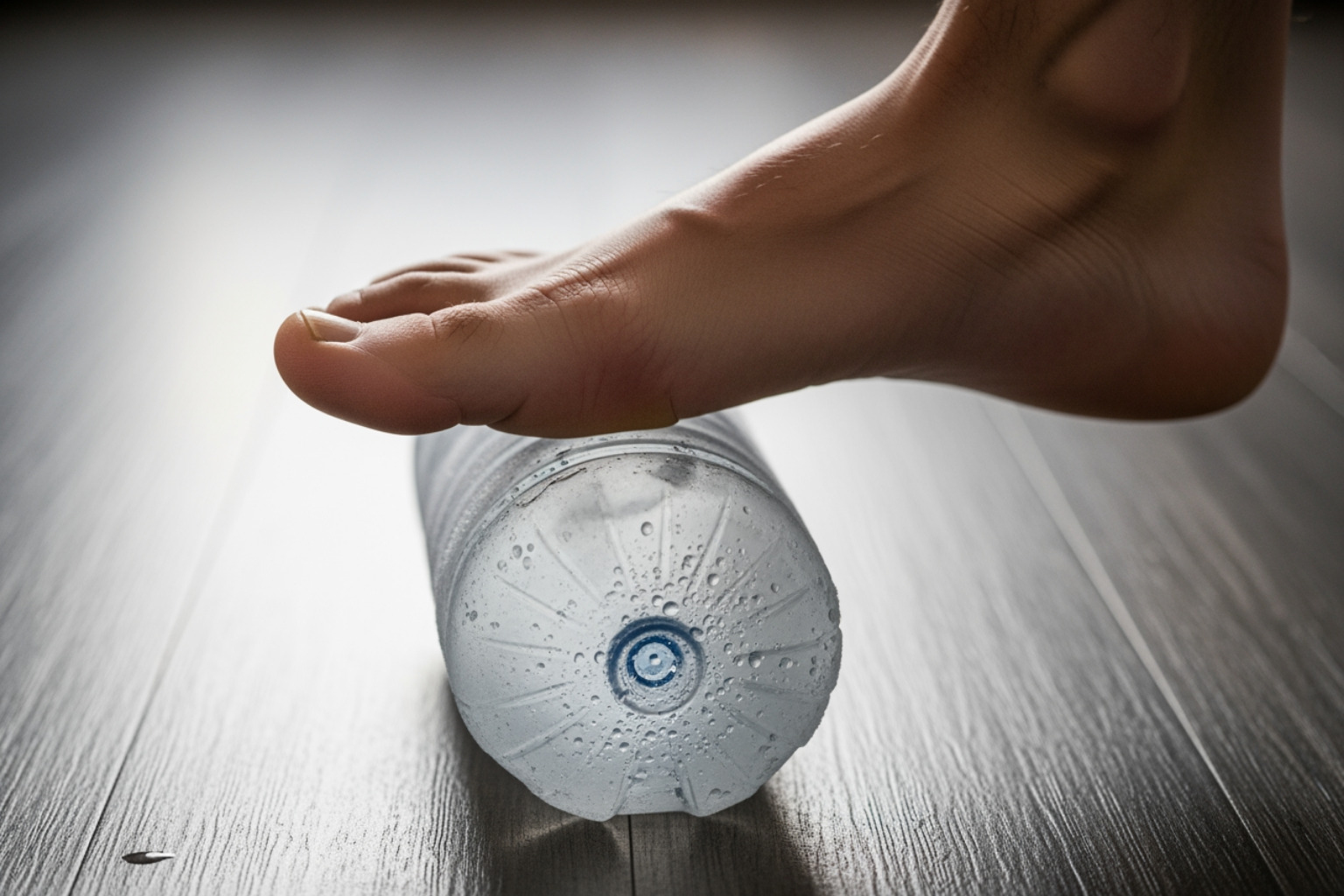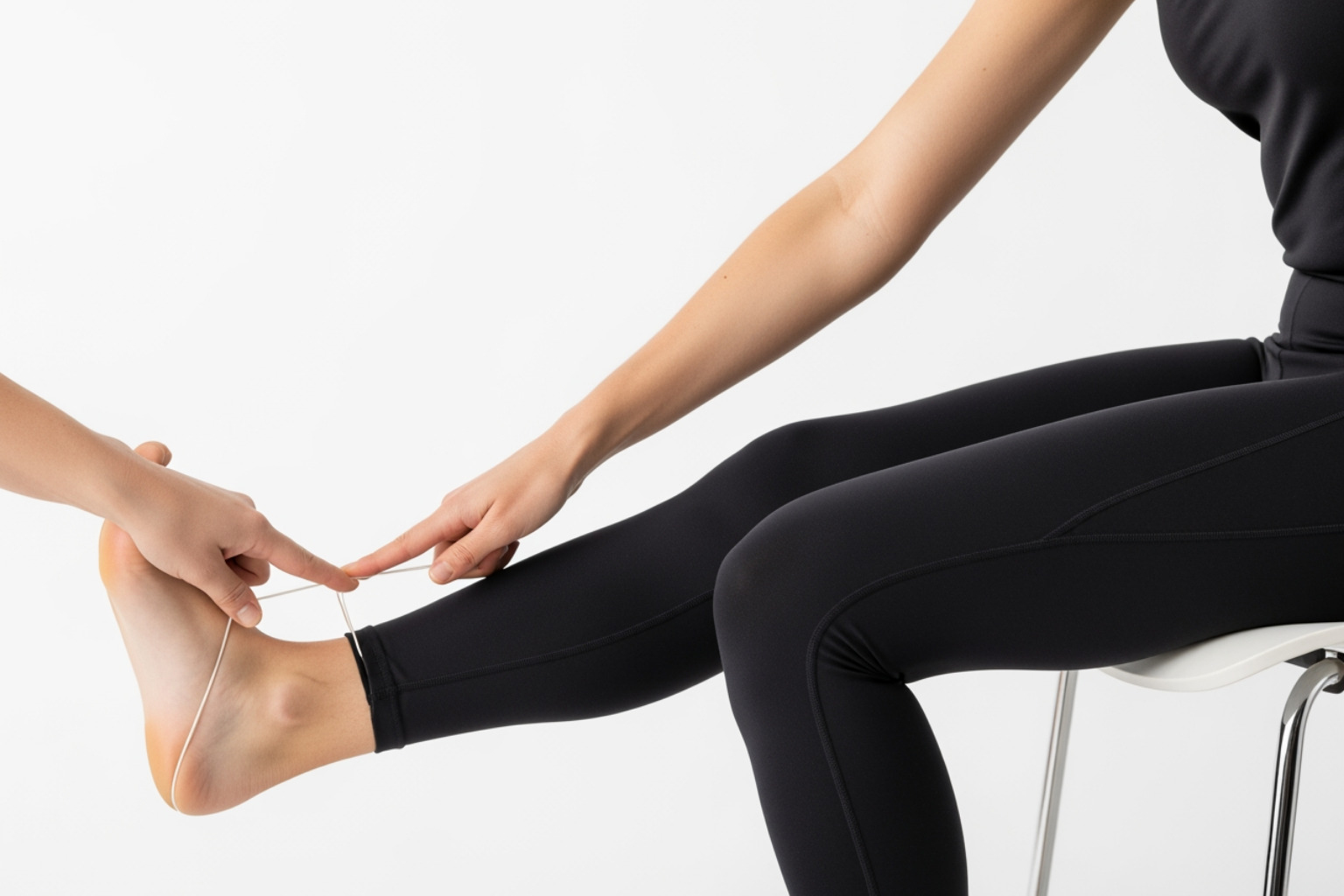Why Foot Arch Pain Demands Your Attention
Foot arch pain relief is a common goal, as studies show 1 in 10 people will experience plantar fasciitis, a primary cause of arch pain, in their lifetime. Whether you're an athlete or just tired of that sharp, stabbing sensation with every step, relief is possible.
Quick Relief Methods:
- Rest and Ice: Apply ice for 15-20 minutes to reduce inflammation.
- Stretching: Perform plantar fascia and calf stretches for 15-30 seconds.
- Supportive Footwear: Wear shoes with proper arch support.
- Topical Relief: Use a fast-acting pain relief cream to soothe discomfort.
- Strengthening: Build foot strength with towel curls and marble pickups.
The arch of your foot is your body's natural shock absorber. When this complex system of bones, ligaments, and tendons breaks down from overuse, poor footwear, or structural issues, the pain can be debilitating. It often starts as a mild ache and escalates to sharp discomfort, especially in the morning.
Most cases respond well to simple, consistent at-home treatments. I'm Tony Enrico, founder of Neuropasil, and I've dedicated my career to helping people find foot arch pain relief. My experience has shown that combining immediate relief with long-term prevention is the most effective approach.

Step 1: Identify the Source of Your Arch Pain
Finding effective foot arch pain relief begins with understanding the cause. Your foot's arch is an intricate system that bears your weight, absorbs shock, and maintains balance. When any part is compromised, pain is the result.
Common Causes of Arch Pain
Most arch pain stems from injury or structural issues. According to Medical News Today, the most frequent culprits include:
- Plantar Fasciitis: This is the most common cause, resulting from inflammation of the plantar fascia, the ligament supporting your arch. For more details, see our guide on what is plantar fasciitis.
- Flat Feet (Fallen Arches): When the arch collapses, it can alter biomechanics and cause pain in the arch, ankles, and legs.
- High Arches (Cavus Foot): An unusually high arch can place excessive pressure on the heel and ball of the foot, leading to instability and discomfort.
- Posterior Tibial Tendon Dysfunction (PTTD): Inflammation or injury to the tendon supporting the arch can cause it to weaken and collapse, leading to pain.
- Overuse: Repetitive stress from running, jumping, or standing all day strains the muscles and ligaments in your arch.
- Weight Gain: Extra body weight increases stress on your feet, which can flatten arches and worsen conditions like plantar fasciitis.
- Improper Footwear: Shoes lacking arch support or cushioning, or walking barefoot on hard surfaces, can trigger or worsen arch pain.
Recognizing the Symptoms
Listen to your body's signals. Key symptoms include:
- A sharp, stabbing pain first thing in the morning or after periods of rest.
- A dull ache in the arch after prolonged standing, walking, or exercise.
- Swelling or tenderness in the arch area.
- Pain that radiates to the heel, ball of the foot, or even up into the legs, knees, and back.
- Stiffness in the foot, especially in the morning.
When to See a Doctor
While home remedies often work, seek professional help if you experience any of the following:
- Pain that persists for more than a few days despite home treatment.
- Severe or worsening pain.
- Inability to bear weight on your foot.
- Visible swelling, redness, or bruising.
- Numbness or tingling, which could indicate nerve involvement.
- You have a chronic condition like diabetes.
Early intervention can prevent more serious problems. If you need to find a healthcare professional, this resource can help: Find a Doctor.
Step 2: Find Immediate Foot Arch Pain Relief at Home
Once you've identified a potential cause, you can take immediate action at home. This first-aid response, which focuses on reducing inflammation and calming pain, is supported by health authorities like the NHS and gives your feet a much-needed break.
The R.I.C.E. Method for Acute Pain
For sudden arch pain, the R.I.C.E. method is a proven strategy:
- Rest: Take a break from activities that trigger the pain. Avoid long periods of standing and give your arch time to recover.
- Ice: Apply a cold pack for 15-20 minutes several times a day to reduce swelling and numb pain. A frozen water bottle rolled under the foot is a great way to combine cold therapy with massage.
- Compression: Use a compression bandage or sock to provide support and minimize swelling. Ensure it's snug but not tight enough to cut off circulation.
- Elevation: Prop your foot up above heart level when resting to help drain fluid and reduce pressure.

Effective Home Remedies for Foot Arch Pain Relief
Beyond R.I.C.E., these home treatments can provide significant comfort:
- Epsom Salt Soak: Soaking your feet in warm water with Epsom salt for 15-20 minutes can help relax tense muscles and ease discomfort.
- Self-Massage: Use a tennis ball or frozen water bottle to roll out the tight spots in your arch. Sit and roll your foot over the ball for 2-5 minutes, applying gentle pressure.
- Topical Pain Relief Cream: For fast, targeted relief, apply a natural cream like Neuropasil directly to your arch. Ingredients like Aloe, Urea, and Menthol provide cooling relief without harsh chemicals. Many find this offers the immediate comfort needed to get through the day. Learn more about natural creams for foot pain.
- Avoid Walking Barefoot: Hard surfaces like tile or wood offer no support. Wear supportive slippers or shoes indoors to protect your arches.
Consistency is key. Regular use of these remedies will give your feet the care they need to heal and provide lasting foot arch pain relief.
Step 3: Perform Targeted Stretches and Exercises
After calming the initial inflammation, it's time to actively rebuild your foot's resilience. Gentle, consistent stretching and strengthening, as recommended by sources like the Cleveland Clinic, can retrain the muscles and ligaments that support your arch, leading to long-term recovery. If any exercise causes sharp pain, ease off. For more ideas, see these exercises for plantar fasciitis.
Stretching for Foot Arch Pain Relief
Stretching improves flexibility in tight tissues, reducing strain on your arch.
- Seated Plantar Fascia Stretch: Before getting out of bed, sit and cross one ankle over the opposite knee. Gently pull your toes back toward your shin until you feel a stretch along the bottom of your foot. Hold for 15-30 seconds and repeat 2-4 times per foot. This can dramatically reduce morning pain.

Wall Calf Stretch: Tight calves often contribute to arch pain. Stand facing a wall, step one foot back, keeping the leg straight and heel down. Lean forward until you feel a stretch in your calf. Hold for 20-30 seconds and repeat 3 times per leg.
Achilles Tendon Stretch: From the wall stretch position, bring your back foot closer and bend both knees slightly. Lean forward to feel the stretch lower down, near your heel. Hold for 20-30 seconds and repeat 3 times per leg.
Strengthening the Muscles in Your Feet
Strengthening builds the muscular support that protects your arch.
Towel Curls: Sit with a towel flat on the floor. Use only your toes to scrunch the towel toward you. Repeat 8-12 times. This strengthens the small intrinsic muscles of your arch.
Marble Pickups: Place 10-15 marbles on the floor next to a cup. Use only your toes to pick up each marble and drop it in the cup. This improves both strength and coordination.
Heel Raises on a Step: Stand on the edge of a step with your heels hanging off. Slowly lower your heels, then rise up onto your tiptoes. Perform 2 sets of 10-15 repetitions to strengthen your calves and improve ankle stability.
Consistency is more important than intensity. A few minutes each day will deliver better results for long-term foot arch pain relief than one long session per week.
Step 4: Choose the Right Footwear and Support
Your shoes can be a hidden culprit behind your arch pain. If you're wearing unsupportive footwear, you're fighting an uphill battle for foot arch pain relief. Proper shoes act as a stable foundation, preventing strain and inflammation.
How Supportive Footwear Helps
The right shoes actively prevent and alleviate arch pain. Look for these key features:
- Proper Arch Support: Built-in support that matches your arch's natural curve helps distribute weight evenly and reduces stress on the plantar fascia.
- Shock Absorption: Quality cushioning acts as a buffer, protecting your arches from the impact of hard surfaces.
- Wide Toe Box: This allows your toes to spread naturally, promoting better foot mechanics and alignment.
- Low, Stable Heel: High heels put excessive pressure on the forefoot and can shorten the Achilles tendon. Stick to shoes with a minimal heel drop.
- Replace Worn-Out Shoes: Athletic shoes lose their supportive properties over time. The American Podiatric Medical Association recommends replacing running shoes every 350-400 miles to ensure they provide adequate support.
Even at home, avoid walking barefoot on hard floors. Wear supportive slippers or house shoes. For more guidance, check out our resource on shoes for plantar fasciitis.
Using Orthotics and Inserts
Orthotics and inserts can provide additional support and correct biomechanical imbalances. The choice between over-the-counter (OTC) and custom options depends on your needs.
| Feature | Over-the-Counter (OTC) Inserts | Custom Orthotics |
|---|---|---|
| Availability | Readily available at pharmacies and shoe stores | Prescribed by a podiatrist or medical professional, custom-made |
| Cost | Generally inexpensive | More expensive due to custom molding and materials |
| Fit | Generic sizing, designed for general foot types | Precisely molded to your foot, addressing unique biomechanical needs |
| Support Level | Provides basic cushioning and some arch support | Offers highly specific support, alignment, and pressure distribution |
| Conditions Best For | Mild arch pain, general discomfort, temporary relief | Chronic pain, specific structural issues (e.g., severe flat feet, overpronation), long-term correction |
OTC inserts are a great starting point for mild to moderate pain. Look for options designed for arch pain or plantar fasciitis. Custom orthotics, prescribed by a specialist, are better for chronic pain or significant structural issues like severe flat feet or overpronation (when your foot rolls inward excessively). By controlling this motion, orthotics keep your foot properly aligned and prevent arch collapse, an approach supported by the American Academy of Orthopaedic Surgeons.
Investing in proper support is crucial not just for immediate relief, but for protecting your mobility for years to come.
Step 5: Implement Long-Term Prevention and Treatment Strategies
Achieving lasting foot arch pain relief means making thoughtful lifestyle changes and knowing when to seek advanced medical help. This step is about building a foundation for healthier feet.
Lifestyle Changes for Lasting Relief
Small, consistent adjustments to your daily habits can prevent pain from returning.
- Weight Management: Even modest weight loss can significantly reduce strain on your arches and plantar fascia.
- Activity Modification: You don't have to give up exercise, just be smarter about it. Switch to low-impact alternatives like swimming, cycling, or using an elliptical machine to reduce stress on your feet.
- Proper Warm-Ups: Always take 5-10 minutes to stretch your calves, Achilles tendon, and plantar fascia before any physical activity to reduce the risk of injury.
- Listen to Your Body: If an activity consistently causes pain, modify or replace it. Pushing through pain often leads to chronic issues.
Advanced Medical Treatments
If home care and lifestyle changes aren't enough, your healthcare provider may recommend more advanced interventions. The following treatments are reviewed in medical literature, such as this overview from the National Center for Biotechnology Information (NCBI):
- Physical Therapy: A physical therapist can create a personalized program of stretches and exercises to address biomechanical issues contributing to your pain.
- Corticosteroid Injections: These injections deliver powerful anti-inflammatory medication directly to the source of pain, providing temporary relief that can create a window for healing.
- Extracorporeal Shockwave Therapy (ESWT): This non-invasive procedure uses sound waves to stimulate blood flow and tissue regeneration in chronically painful areas.
- Night Splints: Worn while sleeping, these devices hold the foot in a flexed position to prevent the plantar fascia from tightening overnight, often eliminating sharp morning pain.
- Surgery: Reserved as a last resort for severe cases that haven't responded to 6-12 months of conservative treatment. Procedures might involve releasing the plantar fascia to reduce tension.
Frequently Asked Questions about Foot Arch Pain
Dealing with arch pain can be frustrating. Here are answers to some common questions.
How long does it take for arch pain to go away?
Healing time varies depending on the cause, severity, and consistency of your treatment. With diligent care, conditions like plantar fasciitis may improve within a few weeks, but complete healing can take several months. According to NCBI research, most cases resolve within a year. The key to faster recovery is consistent stretching, wearing supportive shoes, and preventing re-injury by not rushing back into high-impact activities.
Can flat feet or high arches be corrected?
These are typically natural variations in foot structure, not conditions that need to be "fixed." Surgery is rarely necessary. Instead, these structural differences can be effectively managed with supportive footwear and orthotics (either over-the-counter or custom) to correct alignment and redistribute pressure, an approach recommended by many health experts. Targeted strengthening exercises also help build a stronger internal support system for your feet.
Is walking good for foot arch pain?
It depends. Once acute pain subsides, gentle walking can promote blood circulation and loosen stiff tissues. However, if walking increases your pain, you should back off. Avoid prolonged walks on hard surfaces until your foot has healed. Always wear supportive footwear with good cushioning. If walking is painful, switch to low-impact activities like swimming or cycling to stay active without stressing your arches.
Conclusion: Take the Next Step Towards Pain-Free Feet
Living with foot arch pain is not a requirement. This guide has provided a comprehensive, five-step approach to foot arch pain relief, from identifying the cause to implementing long-term solutions.
We've covered immediate relief with the R.I.C.E. method, rehabilitation through targeted stretches and exercises, and the critical importance of supportive footwear. We also discussed lifestyle changes and advanced medical options for persistent pain.
Consistency is key. Lasting relief comes from a proactive, dedicated approach. Your feet carry you through life, and they deserve this care and attention.
As you implement these strategies, consider adding Neuropasil cream to your toolkit. Our natural formula, with Aloe, Urea, and Menthol, provides fast-acting, soothing comfort for arch pain and plantar fasciitis. Applying Neuropasil can offer that extra layer of relief to help you stay consistent with your recovery.
Ready to take the first step toward pain-free feet? Shop Neuropasil for fast-acting foot pain relief today.
References
Throughout this article, we've drawn on trusted medical sources and expert research to bring you reliable information about foot arch pain relief. We believe in transparency and want you to have access to the same resources we used.
For detailed information on arch pain exercises and treatment approaches, Alberta Health Services provides comprehensive guidance at https://www.albertahealthservices.ca:443/findhealth/default.aspx?source=mha. The Cleveland Clinic also offers excellent evidence-based insights on plantar fasciitis stretches and exercises at https://health.clevelandclinic.org/plantar-fasciitis-stretches-exercises.
We consulted Medical News Today's thorough overview of causes and treatments for arch pain, which you can find at https://www.medicalnewstoday.com/articles/325953. Their articles consistently provide clear, accessible medical information for everyday readers.
The statistics and medical facts about plantar fasciitis came from the National Center for Biotechnology Information (NCBI), a trusted government resource for peer-reviewed medical research: https://www.ncbi.nlm.nih.gov/books/NBK431073/. This comprehensive review has been invaluable in understanding the scope and treatment of this common condition.
For insights into posterior tibial tendon dysfunction and progressive collapsing foot deformity, we referenced OrthoInfo from the American Academy of Orthopaedic Surgeons at https://orthoinfo.aaos.org/en/diseases--conditions/posterior-tibial-tendon-dysfunction/. We also consulted the American Podiatric Medical Association (APMA) for its guidelines on athletic footwear at https://www.apma.org/running-shoes.
The NHS provides practical, patient-friendly guidance on foot pain that we found helpful at https://www.nhs.uk/conditions/foot-pain/pain-in-the-bottom-of-the-foot/. Their approach to explaining medical conditions in plain language aligns with our own philosophy.
Additional perspectives on pain relief methods and prevention strategies came from Orthopedic Foot & Ankle Center at https://orthofootankle.com/blog/foot-arch-pain and Relief Now at https://www.reliefnow.com/articles/how-to-relieve-foot-arch-pain.
We also referenced practical treatment advice from Jaws Podiatry at https://form.typeform.com/to/KTUMi5oo?typeform-source=www.jawspodiatry.com.
These sources represent the foundation of medical knowledge we've synthesized to help you understand and address your foot arch pain. We encourage you to explore them further if you'd like to dive deeper into any particular aspect of foot arch pain relief.













